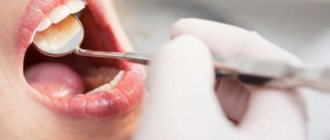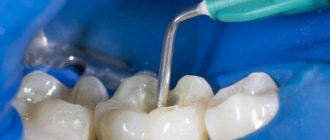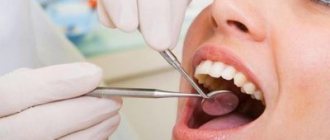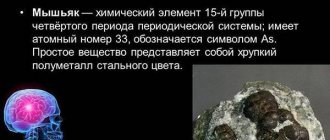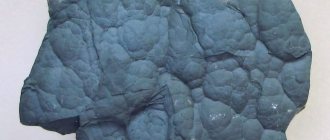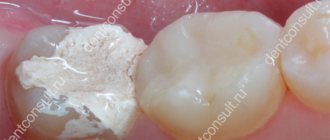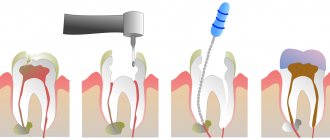Many still remember the time when a visit to the dentist resembled a sophisticated execution. The most vivid impressions were obtained when a nerve was removed from a tooth, and special horror was associated with the word “arsenic.” Modern painkillers relieve toothache quickly and effectively. This allows you to carry out the most complex procedures without physical suffering. Why, against the backdrop of the new generation of painkillers, do dentists still use the good old arsenic?
Tooth hurts after arsenic
The mechanism of interaction between the drug and dental tissues
Arsenic as a poison has been known to mankind since time immemorial. In ancient times, arsenic poisoning was punishable by a severe death penalty: for men - wheeling, for women - drowning after torture. This toxin is still used to kill rats and mice today. For humans, the dangerous dose is 5 mg or more.
Arsenic
Dentists work with a paste whose formula is based on arsenic anhydride. Other ingredients include:
- antiseptics in the form of thymol and camphor, neutralizing microorganisms and disinfecting the pulp;
- anesthetic substances such as lidocaine, novocaine, dicaine, tannin;
- astringent components that provide a prolonged effect of the drug;
- fillers to maintain the required amount.
Arsenic paste
When the chewing organ is painful, this means that the destruction has already affected the soft tissues where the neurovascular bundle is located. This is the last stage of caries, which means that pulpitis or periodontitis develops in the dental tissues, when the exposed nerve reacts sharply to an uncomfortable temperature environment or mechanical irritants.
Advanced caries
The cytotoxic properties of arsenic are used by doctors to kill the sensitivity of the neurovascular bundle. As a result of this procedure, the blood supply to the pulp stops and necrosis occurs, blocking the transmission of nerve impulses in the dental core.
Modern medicine has many options for extracting the dental nerve, but there are only two main methods:
- removal of pulp contents without additional devitalization of the neurovascular bundle. This means that the doctor has come to the conclusion that soft dental tissue must be removed immediately, and such a decision cannot be delayed. The doctor uses local anesthesia and performs all manipulations without killing living tooth tissue. This option is less common;
- Usually, before the procedure, the dentist opens the pulpal contents of the masticatory organ and treats it with a special paste designed to devitalize soft tissue. Popularly the name “arsenic” was assigned to this product. The method of anesthesia using arsenic-based paste is still popular.
Arsenic in the tooth
Diagram of a tooth with arsenic applied
Why do doctors choose the old proven technique? With the right approach, permissible doses of this toxin reliably anesthetize the tooth depulpation procedure without the use of other drugs. The patient only needs to wait a certain time until the unnecessary nerve dies, so that it can be removed without any problems. Many patients are concerned about the question: should they panic if, after adding arsenic paste, the problematic chewing organ begins to hurt? Is he obliged to get sick, and what pain is normal and what is pathology?
Why use
Everyone has long known that arsenic is a poison and has a toxic effect. In large dosages, it poses a mortal danger to humans. But, despite this fact, the substance is actively used in dental practice. He has not only disadvantages, but also advantages. The drug quickly destroys the exposed nerve and provides a powerful analgesic effect. Most often it is used for inflammatory processes of various localizations, which are accompanied by severe pain. It is not used in its pure form, but with various additives: antiseptics, lidocaine, novocaine, tannide.
Now there are many other, safer means for health, used when removing a nerve. Arsenic is not used often, only when there are certain indications. Also, there are several contraindications:
- individual intolerance;
- period of pregnancy and breastfeeding;
- younger children;
- limited access to dental canals;
- diseases of the genitourinary system.
How to get rid of arsenic without medical help
If the timing of using the drug for therapeutic purposes has been missed, and it is not possible to visit the dentist’s office, you can try to extract the paste yourself.
- First of all, maintain hygiene: clean hands, clean teeth. Instruments also need to be disinfected. This could be tweezers, a large sewing (or medical) needle. It is best to boil them and keep them in vodka or potassium permanganate.
Alcohol for sterilizing needles
- It is convenient to remove the temporary filling at the mirror. The main thing is not to touch neighboring healthy tissues and not to go deeper into the dental cavity.
- Under the filling there will be a grayish paste. It must be removed carefully so as not to crumble and swallow arsenic.
- Then the tooth cavity is thoroughly rinsed with a solution of soda or chamomile infusion.
Chamomile infusion for mouth rinse after filling removal
- The tooth cavity is closed with a cotton swab.
After such self-help, you should visit the dentist as soon as possible, since the decaying nerve will contribute to the development of inflammatory processes. If the paste is left in the mouth longer than expected, the paste will destroy the periapical tissue adjacent to the pulp. The next stage will be the occurrence of periodontitis. After just 3 days, the tooth will begin to turn black and decay.
Don't put off visiting the dentist
How toxic is the drug?
Today in dentistry, arsenic paste is used strictly according to indications, since if recommendations are violated or individual characteristics are violated, its toxic properties still manifest themselves. If you take treatment carelessly, complications are possible:
- darkening of dentin;
- development of periodontitis;
- swelling of the pulp;
- necrosis of bone and periosteum;
- general intoxication of the body.
Periodontitis and pulpitis
Today, arsenic paste is contraindicated for pregnant women and children due to its high toxicity, since many new methods for treating pulpitis have been developed.
Arsenic is not used to treat the teeth of pregnant women
How harmful is it?
Arsenic is a poison, but in dentistry it is used in very small doses and is not dangerous when used correctly. The instructions for use state that the maximum dose should not exceed 0.0008 g.
The main tasks are to take precautions, inject the drug into the tooth pulp without introducing dirt, and monitor the health and the body’s reaction to the substance.
If arsenic begins to kill healthy tissue, then even after its removal some of the paste will remain, later leading to inflammation.
Why does an arsenic filling hurt?
When treating a tooth with arsenic, many hope for an immediate cessation of all torment, but the effectiveness of the product increases gradually. Sometimes it takes 2-3 days for complete necrosis of the nerve. As a result, the doctor should receive a completely devitalized pulp, in which there will be no nerve cells that could hurt. After this, he will have the opportunity to calmly remove the waste soft tissue in order to calmly fill the tooth.
For some time after applying arsenic, the tooth continues to hurt. You can make you feel better with the help of Nurofen, Nimesil, Ketorol, Ketanov.
"Nurofen"
"Ketanov" and "Ketorol"
In this condition it is not recommended:
- They put arsenic, but the tooth still hurts
- take large doses of anesthetics;
- warm up the sore side;
- create mechanical stress on the diseased tooth when chewing.
The use of heating pads and warm compresses is not recommended
Do not get carried away with self-medication and pain relief, so as not to miss the phase of transition from normal devitalization to symptoms of pathology. If a tooth hurts for a long time and constantly, this is a dangerous signal, indicating that serious complications have begun, the most severe of which is sepsis.
Prolonged pain indicates the onset of complications
Why does the tooth continue to ache even after such a strong painkiller as arsenic? You cannot endure such pain for a long time, since the consequences of the “feat” are unpredictable. Prolonged discomfort may be a sign of:
- inaccurately selected dosage (in this case, less than the prescribed norm);
- improper treatment of the cavity with arsenic, in particular – a very dense filling;
- advanced forms of the disease, when arsenic is already powerless: with periodontitis, periodontitis, phlegmon, periostitis, abscess;
Tooth abscess is an infectious process that is caused by the accumulation of pus in the inner or outer surface of the alveolar process of the upper jaw or the alveolar part of the lower jaw
- painful reaction to arsenic and other ingredients of the composition (severe allergies and even anaphylactic shock are possible);
- swelling of the gums, fever and other symptoms of periodontitis;
- necrosis of the periosteum and bone tissue;
Necrosis of hard dental tissues
- swelling of the gums in the area of the problematic chewing organ;
- non-compliance with filling technology with arsenic;
- aggressive effect of the drug on dental tissue;
- spread of inflammatory processes from the pulp to the neighboring area.
The exact cause can only be determined through examination; the main thing is not to put off visiting the dentist.
You can't stand the pain, you need to see a doctor urgently
The most common symptoms that should be a cause for concern are presented in the table.
| Symptoms | Description of the causes of the complication | What to do in a specific case |
| Edema | Evidence of a local allergic reaction. Shortness of breath may develop. | Take an anti-allergenic remedy and remove the toothpaste from the tooth in the doctor's office. |
| Redness of the gums | The carelessly applied drug got onto neighboring tissues. | You can wait until the doctor removes the medicine. |
| Black enamel | The enamel layer was exposed to a killing compound. Without bleaching, the stains will be permanently fixed. | The doctor must promptly remove the product and treat the membrane with a special composition that restores the color of the tooth. |
| Weakness, poor health | Drowsiness, dyspeptic disorders, loss of strength, headaches are signs of poisoning that require urgent medical attention. | The dentist must urgently remove the paste and prescribe absorbents that cleanse the organs of toxins. |
The medicine is used strictly according to the norm, but for people with hypersensitivity to its components, this dose is enough to survive all the experiences associated with intoxication. Some patients are afraid to disturb the doctor and bravely wait for the scheduled visit. Such carelessness can sometimes cost not only the health of the tooth, but also the life of the patient.
Tooth pain after using arsenic
This condition is not normal, since the pain should subside after applying arsenic paste. Gradually, the pain goes away completely, since the toxin blocks the nerve, causes its necrosis, and the brain simply does not receive signals about discomfort. But in situations where the pain becomes unbearable, you should immediately seek help from a doctor, since the causes of this condition are usually very dangerous. The side effects described above can cause such pain. Only in some cases, discomfort is caused by an insufficient dose of arsenic or its incorrect placement.
Side effects of arsenic paste can cause toothache
Attention! Regardless of the cause, you should immediately seek help from your doctor, since only a dentist can make an accurate diagnosis. It should be understood that mild aching pain that does not intensify in most cases is the norm. It can be easily eliminated with anti-toothache tablets.
Who is indicated and who is contraindicated for treatment with arsenic?
When is it appropriate to use arsenic? Typically, such a radical remedy is used when other painkillers are not suitable. In particular, the paste kills the neurovascular bundle in the pulp. Other indications include:
- the impossibility of using alternative options for pain relief due to the patient’s health condition (high blood pressure, taking large doses of alcohol);
- urgent medical care in the absence of other suitable methods of pain relief;
- allergic reaction to similar drugs;
- ineffective pain relief with similar medications due to the patient’s high pain sensitivity;
- baby teeth in children who are afraid of local anesthesia injections.
Arsenic on teeth - a time-tested remedy
The use of the composition is contraindicated:
- children under one and a half years old;
- if the roots are not fully formed or are dissolving;
- when it is difficult to reliably clean the canals using other methods (crooked, overgrown, blocked by tartar);
- if you are allergic to the ingredients of the composition;
- if the channels are not properly cleaned and complete sanitation is not carried out;
- in the presence of artificial holes in the root (separation, perforation);
- with increased eye pressure – a precursor to glaucoma;
- for diseases of the urinary system;
- when carrying a child and during lactation.
During lactation, dental treatment is carried out without arsenic
For children, pregnant and nursing mothers, even a small dose of arsenic entering the gastrointestinal tract can give an unpredictable result.
Along with modern anesthetics, arsenic has not lost its relevance, because sometimes it is simply irreplaceable. In the hands of an experienced dentist, he can treat thousands of patients without pain. The main thing is to be attentive to your body, follow caution and all recommendations so that your health is normal.
- How long can an adult keep arsenic in a tooth?
For adults
For a conditionally healthy adult, the drug is prescribed for a period of 1 to 2 days. In this case, an important role is played by the fact on which tooth the arsenic paste is installed, as well as what treatment method is used. Arsenic balls can be placed either on top of the closed pulp or inside after it has been opened.
For 2 days, the paste is placed in a tooth with 2 roots, since it is necessary to remove a larger number of nerve endings, but in other cases, 24 hours is enough.
Children are more susceptible to poisons, so young patients under 18 years of age are given arsenic for less than a day. Typically, the time allotted for arsenic to act in a child’s body is from 16 to 24 hours. Therefore, it is extremely important for parents to take their child to the next appointment on time.
Indications and contraindications for tooth nerve removal
Indications for the procedure:
- pulpitis,
- periodontitis,
- cysts, granulomas,
- trauma leading to pulp damage,
- indications for orthopedic treatment.
Contraindications:
- viral hepatitis;
- high temperature, especially with ARVI;
- cardiovascular diseases;
- leukemia,
- HIV,
- stomatitis;
- mental illness, epilepsy;
- tuberculosis.

